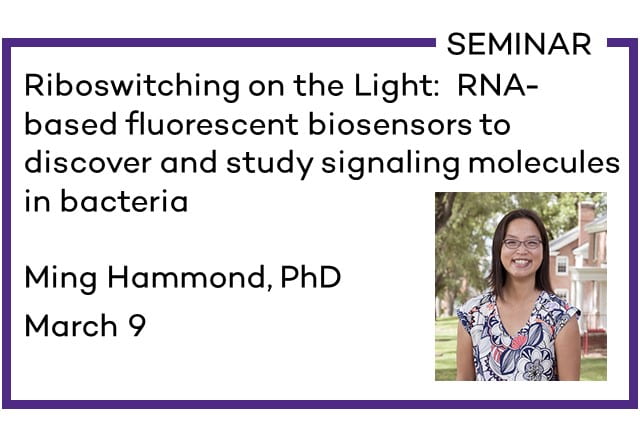TITLE: Riboswitching on the Light: RNA-based fluorescent biosensors to discover and study signaling molecules in bacteria
WHEN: March 9
DESCRIPTION:
Ming Hammond
Associate Professor
Department of Chemistry
The University of Utah
Abstract: The current decade has seen several unexpected discoveries of nucleotide-based signals that control the autonomous behavior of bacteria and immune cells. The newfound signaling pathways may provide new ways to combat antibiotic-resistant pathogens and to enhance the effectiveness of cancer immunotherapy treatments. However, critical questions remain about the biochemistry of the signaling enzymes and cell biology of the signals themselves. Tackling these questions requires tracking nucleotide-based signaling molecules in the complex environment of the cell, which poses a difficult molecular recognition challenge.
My lab has taken a structure-based design coupled to high-throughput screening approach and was among the first to develop RNA-based fluorescent biosensors, or RBF biosensors, for live cell imaging. Our biosensors exhibit remarkable specificity and affinity for nucleotide-based signals, are the brightest to date in live cell imaging studies, and can be rationally reprogrammed to sense new ligands. In this talk, I will present the design principles that enable effective allosteric coupling of ligand binding to fluorescence activation of a small molecule chromophore. We have demonstrated performing, in essence, in vivo biochemistry experiments to track dynamic effects of endogenous chemical cues and inhibitor compounds on enzyme activity in live bacteria. This approach has revealed a new strategy to combat antibiotic resistance. We also have applied these biosensors to make several biological discoveries, including a signaling pathway that regulates how some bacteria interact with redox reactive surfaces. Finally, I will describe another broad application for these biosensors, as novel high-throughput screening assays for enzyme discovery.
Bio: Dr. Ming Chen Hammond is an Associate Professor of Chemistry and part of the leadership at the Henry Eyring Center for Cell & Genome Science at the University of Utah. Her research group was one of the first to develop RNA-based fluorescent biosensors to study signaling and metabolism in living cells, and her research interests span the fields of chemical biology, synthetic biology, and microbiology. She received her B.S. in chemistry at Caltech, Ph.D. in bioorganic chemistry under the supervision of Dr. Paul A. Bartlett at the University of California, Berkeley, and performed postdoctoral training in molecular biology with Dr. Ronald R. Breaker at Yale University. She is the recipient of the BWF Career Award at the Scientific Interface and the NIH Director’s New Innovator Award. She currently serves as Co-Director of the NSF REU in Chemistry and the UoU Beckman Scholar Program at University of Utah, is a member of the Organizing Committee for the 2020 SEED conference, is an Editorial Board member of FEMS Microbiology Reviews, and is co-editor of the Molecular Imaging section of Current Opinion in Chemical Biology.
